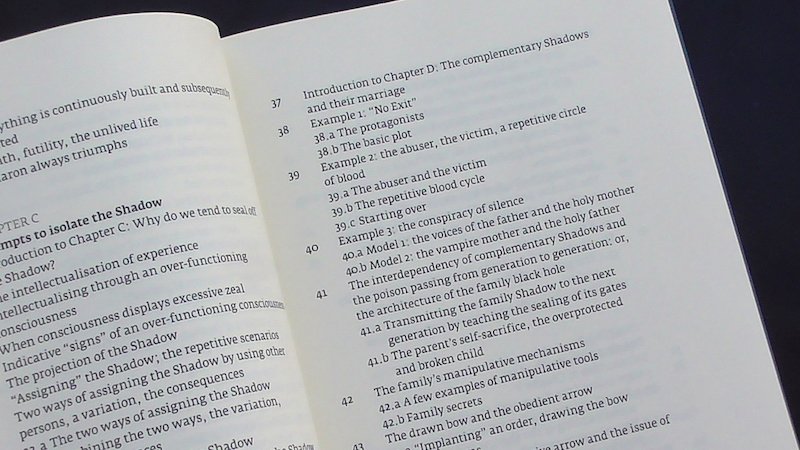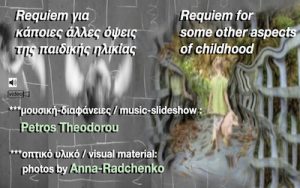********INTRODUCTION***
i.1 What is this book about and to whom it is addressed?
i.2 A brief history, and a few words on the motivation and intentions of this publication
i.3 The “sub-text” of the Quotations and other attributes of the book
********CHAPTER A*** “Shadow”: a first acquaintance
1. What is the Shadow?
2. More on the Shadow and connecting it with the concept of “unfinished business”
3. Interlude: the self and its aspects
3.a The embodied primary self: the mysteries and the basement of “I am”
3.b Consciousness: the penthouse of “I am”
3.c Self as the housekeeper of “I am”: its aspects and the importance of the Shadow
4 The Shadow’s energy
5. The Shadow, and the delusion of fully re-living the past
5.a The uniqueness of our moments
5.b The past can become only a “model” for the present but not the present itself
6 The power of the Shadow, holism, and self-organisation
6.a The Shadow’s effects in our course through life: an approach based on coral principles of “holism”
6.b The threatening Shadow
7 Is the Shadow harmful?
8 Living with the Shadow: can I get to “know” my Shadow?
9 What might be the “self” and the Shadow of a relationship?
10 The Shadow and the “inner child”
11 What we cannot do for our inner child
12 An elegy for “mutated” children
12.a The misfortunes of the monstrous and the deformed
12.b “The Outsider”, or who is afraid of whom?
********CHAPTER B*** What is the Shadow made of?
13 Introduction to Chapter B: The ancient and recent material stored in the Shadow
14 On the distant origins of the Shadow: the eyes in which I was mirrored
14.a The mother as a primary unifying “matrix”
14.b The tremendous importance of the mother for the early construction of the Shadow
14.c Creativity and the Hall of distorting Mirrors
15 Interlude to Chapter B: Feeding the Shadow in adulthood and our “existential givens”
16 Shadow, our uniqueness and our loneliness
16.a Existential and interpersonal loneliness
16.b Who is it that we would like to believe condemned us to a solitary existence?
17 Shadow and meaning
17.a The meaning factory
17.b Meaning, the need for control and the Shadow
18 Armouring the Shadow when things insist on resisting
19 The Shadow, the relativity and ephemerality of meanings, the “fertile void”
20 The Shadow, personal responsibility for choice, and the question of “morals”
21 The Shadow and the lower layers of our nature: are we responsible for our primary emotions?
22 The Shadow, our differences, the rules that govern our collective life
22.a General systems of beliefs and values
22.b Fast-food meanings and their consequences for the reinforcement of the Shadow
23 Shadow and an ancient mutual betrayal as preconditions for individualisation and life
24 Shadow and the one-way betrayal of death
24.a Everything is continuously built and subsequently deleted
24.b Death, futility, the unlived life
24.c Charon always triumphs
********CHAPTER C*** Attempts to isolate the Shadow
25 Introduction to Chapter C: Why do we tend to seal off the Shadow?
26 The intellectualisation of experience
27 Intellectualising through an over-functioning consciousness
28 When consciousness displays excessive zeal
29 Indicative “signs” of an over-functioning consciousness
30 The projection of the Shadow
31 “Assigning” the Shadow; the repetitive scenarios
32 Two ways of assigning the Shadow by using other persons, a variation, the consequences
32.a The two ways of assigning the Shadow
32.b Combining the two ways, the variation, the consequences
33. An example of assigning the Shadow
34 Relationship: projecting and assigning the Shadow
35 The happy and unhappy end of repetitive scenarios in fairy tales, and in life
35.a The happy ending in fairy tales
35.b The unhappy ending in life
36 The futility of repetitive scenarios and of assigning to Others our issues with our Shadow
********CHAPTER D*** The complementarity of Shadows and the darkness of a family’s Shadows
37 Introduction to Chapter D: The complementary Shadows and their marriage
38 Example 1: “No Exit”
38.a The protagonists
38.b The basic plot
39 Example 2: the abuser, the victim, a repetitive circle of blood
39.a The abuser and the victim
39.b The repetitive blood cycle
39.c Starting over
40 Example 3: the conspiracy of silence
40.a Model 1: the voices of the father and the holy mother
40.b Model 2: the vampire mother and the holy father
41 The interdependency of complementary Shadows and the poison passing from generation to generation: or, the architecture of the family black hole
41.a Transmitting the family Shadow to the next generation by teaching the sealing of its gates
41.b The parent’s self-sacrifice, the overprotected and broken child
42 The family’s manipulative mechanisms
42.a A few examples of manipulative tools
42.b Family secrets
43 The drawn bow and the obedient arrow
43.a “Implanting” an order, drawing the bow
43.b Fear blooms
43.c The prayer of the captive arrow and the issue of responsibility
********CHAPTER E*** Further aspects of the Shadow
44 Shadow and the concept of “creative adjustment”
45 The Shadow and “the best I can do”
46 The Shadow itself as a creative adjustment
47 Shadow, guilt, and the non-existence of error
47.a The child who is always wrong, and the idea of “magical thinking”
47.b The adult sense of “error” as an echo from the Shadow and the roots of our adult need for explanations
47.c The non-existence of “error”
48 Examples of adult magical thinking in order to cope with our Shadow
49 Relationship, Shadow and creative adjustment
50 The Shadow and the miracle of embodied existence
50.a The “lived body”, or what has happened to “I think therefore I am”?
50.b Shadow, body
51 The Shadow and our sense of our temporal continuity
51.a The paradox of the continuous reconstruction of time
51.b The Shadow affecting our subjective timeline
*******CHAPTER F*** Dancing with the Shadow
52 Introduction to Chapter F
53 3 ways to avoid the dance with the Shadow
53.a The 1st and 2nd way to avoid the Shadow: (1) cognitive understanding of the Shadow and (2) “catharsis”
53.b The 3rd way to avoid the Shadow: The compulsion to positive thinking
54 Starting the “dance with the Shadow”
55 The present as a solid background to our connection with the past, but not the past as a model for life in the present
56 The importance of “the paradoxical theory of change”
57 Embracing our inner child: the other, the alternative end to the happy end in fairy tales
58 The Shadow, a dish of fruit and a distorting mirror
59 Our story is our story: the inevitable cold that we sense when we open the door to our inner child
60 The inner child, the trap of forgiveness, and the inevitable encounter with ancient anger
61 The sensitive matter of apology and forgiveness
62 The trap within the phrase “I’m finished with that; this issue is closed”: the present holding onto the past
63 The dance with the Shadow as an improvised dance without established steps
64 The importance of the first steps: getting out of the comfort zone
65 “as much … so much” – “stay with it” – “trust the process of change”
********EPILOGUE*** The Loneliness of Asterion
********APPENDIX Ι*** Existential angst, unfathomable depths, “the paradoxical theory of change” and the wisdom of Sisyphus
A.0 The purpose of this appendix
A.1 Life’s injustices and sinking into fathomless depths
A.2 Surrendering to the fall
A.3 The “experiential factory”: substituting “but” with “and”
A.4 How surrendering to the void might stop the fall
A.5 “Trusting the process” – what could good or positive mean?
A.6 The hallucination of the saviour
A.7 Sisyphus and his wisdom: a suggestion about acceptance
A.8 The real power of the “here and now”: “I live” life directly and at the same time “I think about life”
********APPENDIX ΙI*** A few words about my approach PSP (Process-Stage-Praxis
********REFERENCES***
********REFERENCES OF QUOTATIONS***
********QUOTATIONS & AUTHORS: LIST BY NUMBER**
********LIST OF MENTIONED CONCEPTS AND TERMS USED IN GESTALT THEAPY***
The theme of this book of Shadows
is about how some aspects of ourselves seem to escape us and, even if they are non-conscious and non- mentally perceived, they are able to critically affect whatever we are doing or not doing at any moment. It is a visit “down there”, at the sanctuary of our moments and of our selves.
This book is actually a thorough study and at the same time a proposal
about (a) the grandeur (and the drama) of how our experience is composed on both a micro (no-conscious) as well as on a macro (conscious) scale, (b) the architecture of the Shadowed “home” of what is usually called “inner child” – who is not only sad but also very angry…
SHADOW: our silent companion through life’s journey
INFO: [378 pages] [14,2 X 20,2 cm] ISBN 978-618-00-1371-9
1st edition in English: 100 numbered and signed copies.
This edition is published by the author and is to be distributed exclusively
in Greece or delivered in other countries only by order to the author:
[email protected] +30-6977-210469 +30-2310-262872
[email protected]
A video in first person on the central
ideas of the book and its features
2 short videos (no-words) on the ideas of the
SHADOW and the INNER CHILD




